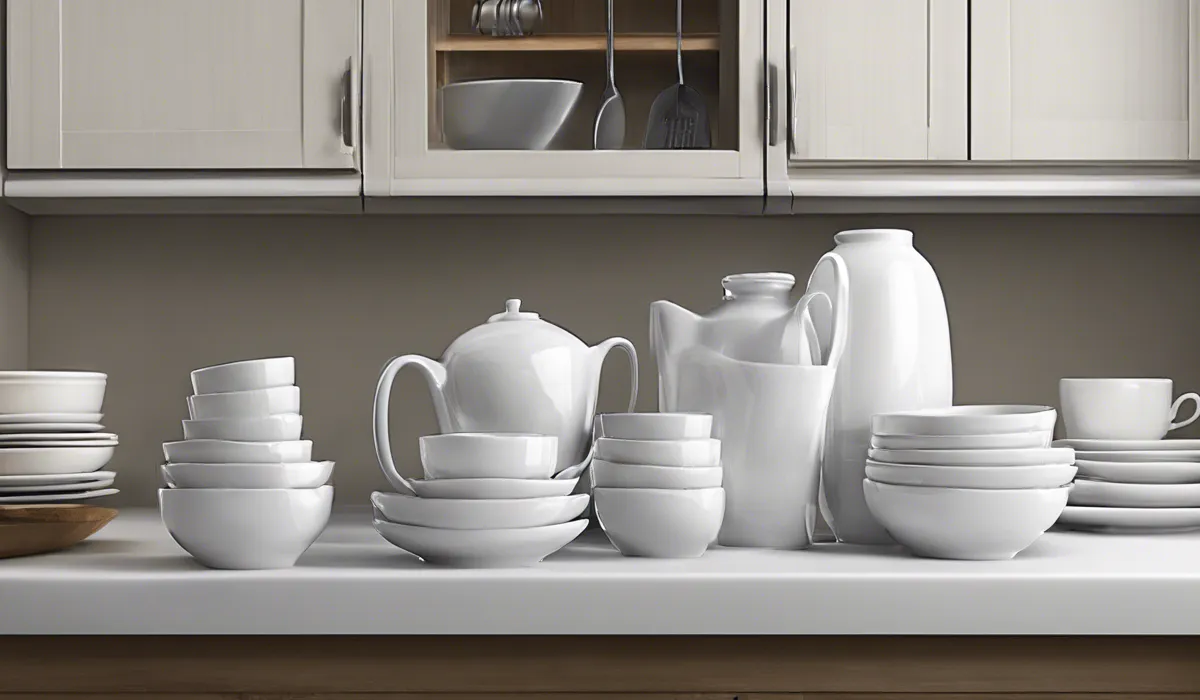Can Porcelain Go in the Dishwasher? Myths & Facts Unveiled
Yes, porcelain can generally go in the dishwasher. However, check for a dishwasher-safe label to ensure it won’t be damaged by high heat or detergents. Avoid washing antique or hand-painted porcelain in the machine.
Understanding Porcelain and Dishwasher Safety

Definition of Porcelain and Its Characteristics
Porcelain is a type of ceramic that is valued for its beauty, strength, and durability. Made by heating materials, such as kaolin, in a kiln to high temperatures, it results in a dense, glass-like material.
Porcelain is known for its smooth surface, translucent appearance, and resistance to heat and liquid. These properties make it a popular choice for dinnerware and decorative items.
General Considerations for Dishwashing Porcelain Items
When deciding if porcelain should go in the dishwasher, it’s essential to consider its design and how it’s made. Most contemporary porcelain is dishwasher safe, but always check for a label or manufacturer’s guidance.
Items without adornments are usually good candidates for dishwashing, as long as they fit securely and won’t be knocked around during the cycle.
Factors Affecting Dishwasher Safety
The dishwasher safety of porcelain can be influenced by several factors. Glaze quality is crucial; a high-quality glaze will protect the porcelain from the harsh environment inside a dishwasher.
Porcelain with gold or metallic accents should not be machine washed, as the heat and detergents can dull or remove these embellishments.
Additionally, the age and condition of the porcelain play a role; older or already damaged items are best washed by hand to prevent further wear.
Best Practices for Washing Porcelain in the Dishwasher

Sorting and Placing Porcelain Correctly in the Dishwasher
To prevent damage, porcelain items should be placed securely in the dishwasher, ensuring they do not touch each other. Plates can go on the bottom rack, while cups and bowls are best on the top.
Larger items should not block the spray arms or the detergent dispenser. By sorting and placing your porcelain carefully, you can help maintain its beauty.
Recommended Dishwasher Settings for Porcelain
Use a gentle cycle with a low temperature for porcelain dishware, which will clean effectively without causing harm. The ‘china’ or ‘delicate’ settings on many dishwashers are specifically designed for this purpose.
A lower temperature cycle not only protects the glaze but also prevents any thermal shock that could crack or weaken the porcelain.
The Importance of Using Gentle Detergents
Harsh detergents can etch the surface of porcelain, so it is advisable to use mild, bleach-free dishwasher detergents.
These gentle detergents will clean your porcelain effectively without diminishing its shine or integrity. Rinse aids can also help by reducing water spots and helping your porcelain to dry more efficiently.
Drying Tips to Prevent Water Spots or Damage
After washing, remove porcelain from the dishwasher and dry it by hand with a soft towel to prevent water spots.
If you prefer to use the heat dry setting, ensure it is on a low setting to avoid any damage. Proper drying techniques will help maintain the beauty and longevity of your porcelain dinnerware.
Alternative Cleaning Methods for Porcelain

Hand-Washing Techniques for Delicate Porcelain
For delicate or antique porcelain, hand-washing is the safest option. Use a soft sponge or cloth and mild detergent in warm water, and avoid abrasive pads or harsh chemicals.
Rinse with clean water and dry gently with a towel. Treat your porcelain with care to avoid any chips or cracks.
When to Choose Hand-Washing Over the Dishwasher
Hand-washing should be chosen over the dishwasher when dealing with porcelain that is antique, hand-painted, has gold or metallic accents, or is already compromised in some way.
This method allows for a more controlled environment that can protect the fine details and preserve the item’s integrity.
Tips for Maintaining the Longevity and Aesthetic of Porcelain Dinnerware
To maintain the longevity and beauty of your porcelain, avoid sudden temperature changes and stacking heavy items on top of plates or bowls. Store your porcelain in a location where it is not likely to be bumped or knocked over.
Regular gentle cleaning, careful storage, and handling with love and care will ensure your porcelain remains a treasured part of your home for years to come.
FAQs About Porcelain in the Dishwasher
Can all porcelain dishes go in the dishwasher?
Most porcelain dishes can go in the dishwasher, but always check for a dishwasher-safe label first to ensure they won’t be damaged.
How can I tell if my porcelain is dishwasher safe?
Look for a label or manufacturer’s mark indicating that the porcelain is dishwasher safe. If in doubt, wash it by hand.
Can antique or hand-painted porcelain be washed in the dishwasher?
Antique or hand-painted porcelain should generally be washed by hand to avoid damage from high heat or detergents.
Will the dishwasher damage my porcelain items?
Porcelain that is labeled as dishwasher safe should not be damaged by the dishwasher under normal conditions.
Are there specific detergents recommended for porcelain in the dishwasher?
It’s best to use a gentle detergent that is suitable for delicate items when washing porcelain in the dishwasher.
Final Thoughts
Porcelain items can often be safely cleaned in the dishwasher. It’s important, though, to verify this by looking for a mark indicating they are dishwasher-safe, as the high temperatures and detergents can sometimes cause damage.
Particularly delicate pieces, such as antiques and those with hand-painted designs, should be washed by hand instead.





